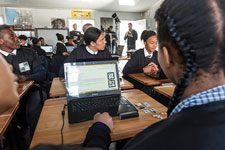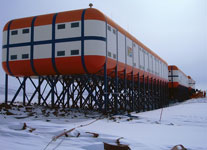
From collecting data in sub-zero Antarctica to rapid circuit prototyping on the International Space Station (ISS), XinaBox, a South African company with humble beginnings, is reinventing the way we approach IoT while inspiring students to follow STEM (science, technical, engineering and mathematics) careers.
In 2008 Bjarke Gotfredsen and Judi Sandrock founded Meta Economic Development Organisation (MEDO) – a South African non-profit development organisation implementing bespoke entrepreneurship and secondary level STEM education programmes. Their initial target was to leverage space science to motivate students in high schools across South Africa to pursue STEM careers.
They started to experiment with modularising computer chips which could be connected without soldering components together in an effort to improve safety for the students while fast tracking the process to complete experiments. The company was successful in overcoming this barrier found in electronics and developed various xChips modules that are now sold under the trading name XinaBox.
Pronounced ‘X-in-a-box’, the company was formally established in 2015 by Bjarke, Judi and Daniel Berman with its home base in South Africa while being registered in Ireland and the USA for patent and distribution purposes.
xChips are a modularised set of computer chips that can be used to make a weather station, satellite or even a rocket. The components are plug-and-play and can be reused for different applications in the rapid development and prototyping of products as well as STEM type experiments at school and university level.
The broad range of xChip modules from XinaBox encompasses processor boards, cores, sensors, power, communication, output, control and storage devices; as well as a variety of supporting functions including LoRa, Bluetooth and Wi-Fi, OLED displays, capacitive touch sensing, proximity sensing, temperature sensing, humidity sensing, universal digital and analog input modules, with more being added on an ongoing basis.

Judi Sandrock said that XinaBox was developed to be used in schools and maker spaces so that users could build electronics without soldering, breadboarding or using any consumables. “The xChips are affordable, re-usable and robust enough to build satellites for launch into space. XinaBox has changed STEM education dramatically by ensuring that students and makers can get straight into IoT and software development without any electronic knowledge or lab equipment.” XinaBox kits are already being used in schools in the USA and South Africa with great success.
The xChip concept makes a wide variety of electronic functions available in a standardised modular format that can be assembled, in any order, to build electronic devices quickly and easily. No soldering or breadboarding is required and users can begin coding in minutes without prior electronics knowledge, as there is no need to design and debug hardware.
xChips work in all popular programming environments. The xChips allow for seamless integration with single board computers (SBC), embedded systems and other hardware programming environments. Some of the xChips are developed for building weather stations and science experiments in Extreme Low Earth Orbit (ELEO) on board small satellites.
In 2017, the versatility and affordability of the chips caught the attention of Brian Andrew, managing director for RS Components in sub-Saharan Africa. He facilitated a meeting with the global team and after being reviewed, the range was approved for release in 2018 and is now sold worldwide through the various RS websites.
Andrew said that he was taken aback by the ingenuity of XinaBox. “When I was first introduced to Xinabox and the xChips, I knew that it was something that had to be part of the global RS range. I’m really proud that we have a South African invention to take to the rest of the world. This product is a game changer for the IoT industry and STEM education. The best part is that it is compatible with Raspberry Pi, Arduino and other development boards. It’s a simple plug-and-play solution forged in the heart of Africa,” he said.
XinaBox on-board the International Space Station (ISS)

In February 2020, XinaBox partnered with US-based organisation Quest for Space to launch experiments to the International Space Station (ISS). The XinaBox experiment was launched towards the ISS on February 7, 2020 with the newly-developed XK92 xChips – XinaBox’s latest kit developed for the ISS mission. The kit was on-board the unmanned Northrop Grumman NG-13 Launch Vehicle from National Aeronautics and Space Administration’s (NASA) Wallops Flight Facility in Wallops Island, Virginia.
While on-board the ISS, the XinaBox payload will collect data such as pressure, temperature, humidity, G-force and acceleration. The information will be stored on an SD card to be assessed once the experiments return to Earth.
XinaBox monitors environment in Antarctica

Since mid-February 2020, an XinaBox environmental monitoring rig, made from the flagship XK01 kit, was placed outside the Antarctic’s SANEA IV base – monitoring and reporting live data to an IoT platform. This research station is located over 4000 km south of Cape Town in Vesleskarvet, which is about 160 km from the edge of the ice shelf. The South African National Space Agency (SANSA) and South African National Antarctic Programme (SANAP) use the base for research in the fields of oceanography, biology, geology, geomorphology and renewable energy.
Supported by SANSA, the XinaBox environmental monitoring rig aims to engage school children from South Africa and around the world, by giving them a chance to be a part of this mission and contribute to the science that is undertaken at the base station.
| Tel: | +27 11 691 9300 |
| Email: | [email protected] |
| www: | www.rs-online.co.za |
| Articles: | More information and articles about RS South Africa |

© Technews Publishing (Pty) Ltd | All Rights Reserved